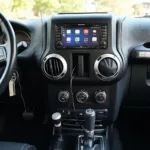OBD1 and OBD2 are terms you’ll likely encounter if you’re delving into car diagnostics. These systems, short for On-Board Diagnostics, are the backbone of modern vehicle maintenance and repair. Understanding the differences between OBD1 and OBD2 is crucial for anyone working with cars, from professional mechanics to DIY enthusiasts. This guide will explore the nuances of each system, highlighting their evolution and impact on the automotive industry.
Understanding OBD1: The Precursor
OBD1, the first generation of on-board diagnostics, marked a significant step towards computerized car maintenance. Introduced in the late 1980s, OBD1 systems primarily focused on emissions control. Unlike the standardized OBD2, OBD1 varied significantly between manufacturers, making diagnosis more challenging. Each carmaker had its own proprietary connectors, diagnostic trouble codes (DTCs), and procedures. Imagine having to learn a new language for every car brand you worked on! This lack of standardization made OBD1 less user-friendly and often required specialized equipment for each vehicle.
While OBD1 offered basic diagnostic capabilities, its limitations were evident. It primarily monitored the engine and emissions systems, leaving other crucial components largely unchecked. Furthermore, the data provided by OBD1 was often limited and cryptic, requiring further interpretation. Think of it like getting a vague clue instead of a clear answer. Despite its shortcomings, OBD1 paved the way for the more advanced and standardized OBD2 system.
Embracing Standardization: The OBD2 Revolution
The advent of OBD2 in the mid-1990s revolutionized automotive diagnostics. Mandated by the U.S. Environmental Protection Agency (EPA), OBD2 introduced a standardized connector, communication protocol, and DTCs across all car manufacturers. This standardization simplified diagnostics immensely, making it accessible to a wider range of users. Now, a single OBD2 scanner could be used to diagnose issues on virtually any car, regardless of the brand. This is akin to having a universal translator for all car languages.
OBD2 expanded its diagnostic scope significantly, covering not only the engine and emissions but also other vital systems like the transmission, ABS, and airbags. The data provided by OBD2 is much more comprehensive and detailed, enabling more precise diagnostics and targeted repairs. It’s like having a detailed map instead of just a compass. Moreover, OBD2’s standardization fostered the development of affordable and user-friendly OBD2 scanners, empowering car owners to take control of their vehicle’s maintenance.
Key Differences between OBD1 and OBD2: A Quick Overview
- Standardization: OBD2 is standardized across all vehicle makes and models, while OBD1 varied significantly.
- Diagnostic Scope: OBD2 covers a wider range of vehicle systems, providing more comprehensive diagnostics.
- Data Quality: OBD2 offers more detailed and precise data, facilitating accurate troubleshooting.
- Accessibility: OBD2 scanners are more affordable and user-friendly, making diagnostics accessible to a broader audience.
What does OBD2 mean for the average car owner?
OBD2 empowers car owners to understand their vehicles better. With an affordable OBD2 scanner, you can diagnose check engine lights, monitor vehicle performance, and even clear minor trouble codes. This allows for preventative maintenance and helps avoid costly repairs down the road. Imagine being able to catch a small issue before it turns into a major problem!
obd1 harness to obd2 injectors
Conclusion: OBD2: The Future of Car Diagnostics
From the fragmented landscape of OBD1 to the standardized world of OBD2, automotive diagnostics have come a long way. OBD2 has simplified troubleshooting, empowered car owners, and paved the way for more advanced diagnostic tools and techniques. Understanding the differences between OBD1 and OBD2 is essential for anyone working with vehicles. While OBD1 served as a crucial stepping stone, OBD2 is undoubtedly the future of car diagnostics, offering greater accessibility, accuracy, and control over vehicle maintenance. Knowing the “que es obd1 y obd2” empowers you to make informed decisions about your vehicle’s health and maintenance.
1996 gmc 1 ton dually work truck obd1 or obd2
Frequently Asked Questions
- What is an OBD2 port? The OBD2 port is a standardized 16-pin connector typically located under the dashboard on the driver’s side.
- Can I use an OBD2 scanner on an OBD1 car? Generally, no. You would need an adapter and potentially manufacturer-specific software.
- What does a check engine light mean? A check engine light indicates a potential issue detected by the OBD2 system.
- How do I clear a check engine light? While you can sometimes clear the light with an OBD2 scanner, it’s crucial to address the underlying issue causing the light to illuminate.
- What are OBD2 trouble codes? Trouble codes are standardized codes that indicate specific malfunctions detected by the OBD2 system.
- Where can I find information on OBD2 trouble codes? Numerous online resources and OBD2 code readers provide detailed explanations of trouble codes.
- Are all OBD2 scanners the same? No, OBD2 scanners vary in features, capabilities, and price.
For further assistance, please contact us via WhatsApp: +1(641)206-8880, Email: [email protected] or visit us at 789 Elm Street, San Francisco, CA 94102, USA. Our customer support team is available 24/7.
